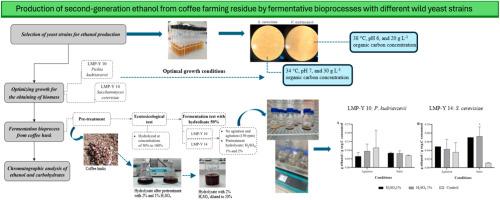利用不同野生酵母菌株发酵生物工艺从咖啡农渣中生产第二代乙醇
IF 5.8
2区 生物学
Q1 AGRICULTURAL ENGINEERING
引用次数: 0
摘要
生物乙醇是一种可再生能源替代品,可以从富含有机物质的生物质中生产,如咖啡秸秆,这是巴西丰富的农业工业废物。本研究对两株野生酵母的发酵生物过程进行了评价,并利用间歇热化学水解咖啡秸秆获得的水解液制备第二代乙醇。对从啤酒废水和腐烂果实中分离得到的15株野生酵母进行了分子鉴定。筛选结果显示,产乙醇量最高的菌株为毕赤酵母(Pichia kudriavzevii, lmp - y10)和酿酒酵母(Saccharomyces cerevisiae, lmp - y14),分别为1.64和1.91 g L−1。根据生物质产量优化,lmp - y10在38℃、20 g L−1葡萄糖、pH 6.0条件下和lmp - y14在34℃、30 g L−1葡萄糖、pH 7.0条件下的生物质产量更好。在分批系统中对水解咖啡壳进行发酵生物过程试验,用h2so1 %和2%预处理,有和没有搅拌,结果表明h2so2 %的乙醇产量更好,在搅拌条件下,lmp - y10的乙醇产量为0.58 g L−1,在静态条件下,lmp - y14的乙醇产量为0.43 g L−1(在20 mL培养物中,F/M比= 1)。研究结果揭示了两种以前未被研究过的野生菌株,它们具有通过咖啡壳的增值生产第二代生物乙醇的强大潜力,可以为未来的生物技术研究和进步做出贡献,为从农业工业废物中生产生物能源提供可持续的替代方案。本文章由计算机程序翻译,如有差异,请以英文原文为准。

Production of second-generation ethanol from coffee farming residue by fermentative bioprocesses with different wild yeast strains
Bioethanol is a renewable energy alternative and can be produced from biomass rich in organic matter such as coffee straw, an abundant agro-industrial waste in Brazil. This study evaluated fermentative bioprocesses with two strains of wild yeasts and using hydrolysate obtained in the treatment of coffee straw by thermochemical hydrolysis in batch systems for obtaining second-generation ethanol. The molecular identification of 15 strains of wild yeasts isolated from brewery wastewater and decaying fruit was performed. A screening of those strains revealed Pichia kudriavzevii (LMP-Y 10) and Saccharomyces cerevisiae (LMP-Y 14) showed the best ethanol production (1.64 and 1.91 g L−1, respectively). According to the optimization of biomass production, LMP-Y 10 at 38 °C, 20 g L−1 of glucose, and pH 6.0 and LMP-Y 14, at 34 °C, 30 g L−1 of glucose, and pH 7.0 provided better biomass yield. Fermentation bioprocess assays in a batch system from hydrolyzed coffee husk pretreated with H2SO4 1 % and 2 %, with and without agitation, led to better ethanol production with H2SO4 2 %, obtaining 0.58 g L−1 with LMP-Y 10, under agitation, and 0.43 g L−1 with LMP-Y 14, in static condition for both strains (in 20 mL of cultures at an F/M ratio = 1). The results reveal two previously unstudied wild strains with strong potential for second-generation bioethanol production through the valorization of coffee husk that can contribute to future research and advances in biotechnology, offering sustainable alternatives to produce bioenergy from agro-industrial waste.
求助全文
通过发布文献求助,成功后即可免费获取论文全文。
去求助
来源期刊

Biomass & Bioenergy
工程技术-能源与燃料
CiteScore
11.50
自引率
3.30%
发文量
258
审稿时长
60 days
期刊介绍:
Biomass & Bioenergy is an international journal publishing original research papers and short communications, review articles and case studies on biological resources, chemical and biological processes, and biomass products for new renewable sources of energy and materials.
The scope of the journal extends to the environmental, management and economic aspects of biomass and bioenergy.
Key areas covered by the journal:
• Biomass: sources, energy crop production processes, genetic improvements, composition. Please note that research on these biomass subjects must be linked directly to bioenergy generation.
• Biological Residues: residues/rests from agricultural production, forestry and plantations (palm, sugar etc), processing industries, and municipal sources (MSW). Papers on the use of biomass residues through innovative processes/technological novelty and/or consideration of feedstock/system sustainability (or unsustainability) are welcomed. However waste treatment processes and pollution control or mitigation which are only tangentially related to bioenergy are not in the scope of the journal, as they are more suited to publications in the environmental arena. Papers that describe conventional waste streams (ie well described in existing literature) that do not empirically address ''new'' added value from the process are not suitable for submission to the journal.
• Bioenergy Processes: fermentations, thermochemical conversions, liquid and gaseous fuels, and petrochemical substitutes
• Bioenergy Utilization: direct combustion, gasification, electricity production, chemical processes, and by-product remediation
• Biomass and the Environment: carbon cycle, the net energy efficiency of bioenergy systems, assessment of sustainability, and biodiversity issues.
 求助内容:
求助内容: 应助结果提醒方式:
应助结果提醒方式:


